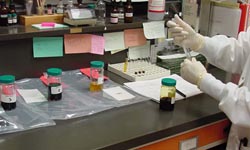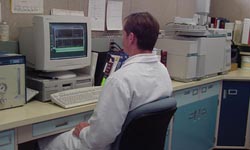Impaired Driving Program
Agency Involvement: Department of Public Safety
 DPS Toxicology Meth Lab Analysis |
 DPS Toxicology BAC Analysis |
 DPS Toxicology BAC Analysis |
The Department of Public Safety
Crime Lab Toxicology
Nita Bolz
Chemistry and Toxicology Supervisor
dps.scdl.toxicology@alaska.gov
907-269-0599
Project Overview:
Alaska does not have a toxicology lab and evidential-quality toxicology analysis must be performed in a laboratory with the equipment, staff, and training to provide this service. A successful arrangement between Alaska Crime Lab and the Washington State toxicology lab, in Seattle, WA has been ongoing with continued funds received from the AHSO. This project is intended to reduce the number and severity of drug-impaired driving cases on highways and road systems by making it possible for drug impaired cases to be brought to trial at a comparable rate and success as the alcohol impaired cases.
In order for the DUI-drug interdiction to take place, various elements are necessary for success, such as: having the expert analysts who performed the toxicology work introduce their results when called into court, police officers must be trained regarding specific clues of impairment exhibited by drug impaired drivers distinct from alcohol impaired drivers, Drug Recognition Experts(DRE) officers need the proper training and materials to perform their specialized duties, and finally, prosecutors need training and support for preparing these cases and judges need training to assess the merit of the arguments heard.
Statistics:
In 2006, 3844 drivers whose breaths were tested for alcohol content with measured results. These drivers had been arrested for impaired driving and processed as drunk drivers. 370 or 9.6% of these drivers were found to be alcohol free or had low breath alcohol results (BACs). Some other substance other than alcohol is strongly implicated in these cases. This sample shows that Impaired Driving is on the rise. The 2006 results are higher than the 2004 numbers, which 257 out of 4801 tests or 5.3% of impaired drivers with low BACs and 2003, 208 out of 4256 or 4.3%.
Without this evidence, these cases would have been reduced to a negligent driving charge or dropped all together.
Impaired Driving
- Overview page
- Drink. Drive. Go to Jail.
- Alaska Strategic Traffic Enforcement Partnership (ASTEP)
- Agency Involvement: Alaska Court System
- Agency Involvement: Center for Safe Alaskans
- Agency Involvement: DMV
- Agency Involvement: Department of Public Safety
Safety Topics
- DEC / DRE
- Distracted Driving
- Fatality Analysis Reporting System (FARS)
- Headlights
- LEL - Law Enforcement Liaisons
- Low Speed Vehicles
- Media Campaigns
- Mock Crashes
- Moose Safety
- Occupant Protection
- REDDI
- Safe Communities
- DUI Information & Impaired Driving
- Safety Corridor
- Senior Driving in Alaska
- Teen Driving in Alaska
- Snowmobiles and ATVs
- Traffic Records
Please note: You must have Acrobat Reader to open any ![]() documents on this page. If you do not have Acrobat Reader, click to download the FREE software.
documents on this page. If you do not have Acrobat Reader, click to download the FREE software.
